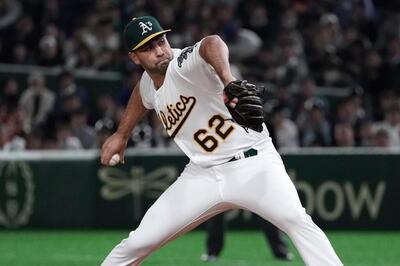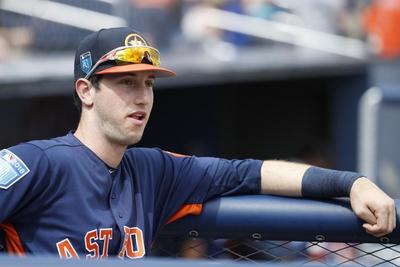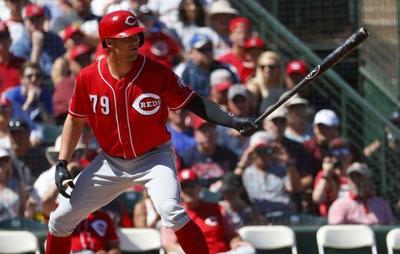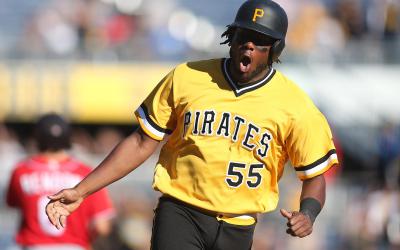As you can see by yesterday's mailbag article by Lou, we get our fair share of email around here and we try our best to get to all of it and respond. Sometimes we'll respond back through email, through our player write-ups, and today I'm going to address an email we received here in the First Pitch section.
The subscriber asked about measuring pitchers by a statistic he termed "Disaster Starts". Rightly so, the subscriber identified that we spend plenty of time preaching about Quality Start Percentage and how it can be a strong indicator of a pitcher's value, but we hadn't focused much on "Disaster Starts"and how they can impact a pitcher's value. The concept intrigued me. We spend a lot of time talking about pitcher's value and lots of times we might label a specific pitcher a "spot-starting"option. The reason we're doing this is we're trying to avoid those "Disaster Starts". A "Disaster Start"has more of a negative impact on a fantasy team than missing a Quality Start, because it takes multiple Quality Starts to make up for the negative impact of a "Disaster Start"while a missed Quality Start can simply be replaced by 1 Quality Start added later on in the year.
Since we're essentially creating a statistic here, let me define what I used as a qualifier for a "Disaster Start". The subscriber's suggestion was any outing in which the pitcher allowed more Earned Run's than Innings Pitched. I thought this was a good start but also thought to myself if a pitcher went 6 innings and allowed 5 ER's (ERA of 7.50) they're setting us back a bit as well. So I expanded the criteria a bit. For this example I'm defining a "Disaster Start"as any start in which the pitcher allowed as many ER's as IP or any start in which a SP allowed 5 ER's or more. While adding the 5 ER caveat added to the overall number of Disaster Starts, I felt it was a bit more inclusive of the ultimate goal, which is avoiding those starts in which it will take multiple Quality Starts to make up.Â
So now that we've got the definition, how did I go about collecting the data? Well the first thing I did was take every Starting Pitcher that averaged over 20 Starts per season for the last 3 years. If a pitcher only pitched in 2005 and made 25 starts, they'd qualify with an average of 25 starts per year. This left us with 120 Starting Pitchers that qualified. At this point I looked through the game logs of every start for these pitchers and hand counted the aforementioned new statistic we're calling Disaster Starts. I then took the % of a Starting Pitcher's Quality Starts and the % of a Pitcher's Disaster Starts and compared them. For comparison's sake I'm going to post the top 30 and bottom 30 of each. This will give us the top and bottom quartile for each statistic. Clearly their should be overlap between the top 30 in Quality Starts and the top 30 of those pitchers that avoid Disaster Starts. It also should be known that the difference between the top 30 and bottom 30 in Quality Starts and Disaster Starts was only 8%.
Let's take a look at the Top 30:
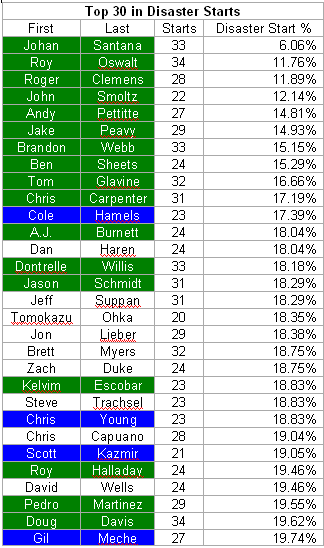
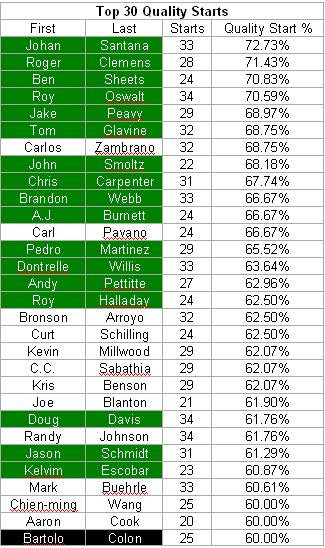
The Green highlights stand for names that appear on both Top 30 lists. The Blue stands for players in the Top 30 in avoiding Disaster Starts but Bottom 30 in Quality Starts. The Black stands for players in the Top 30 in Quality Starts but the Bottom 30 in avoiding Disaster Starts.
Eighteen of the Thirty names on the list are repeats and for the most part the names that are reappearing are familiar and to be expected. The surprising names on both lists probably include: 1) Doug Davis, who's 2004-2006 run was a bit underappreciated but recently has seen a significant drop in his K Rate accompanied with a high BB Rate; 2) Kelvim Escobar, who's been undervalued in fantasy circles for years now, with his only true downfall being his ability to stay healthy.
We've stressed Quality Starts % in the past so I won't take too much time analyzing that chart, but certainly some undervalued pitchers in this area over the last 3 years include: Aaron Cook and Joe Blanton. The other surprises on the list include Kris Benson, who's hurt this year and did much of his damage in the NL, and Carl Pavano who's living off his stellar 2004 when being evaluated in this data.
The whole reason we were conducting this experiment was to identify some pitchers that have shown an ability to protect their owners from those devastating starts the past 3 years. David Wells, Steve Trachsel, Zach Duke, Tomo Ohka, Jon Lieber, and Jeff Suppan are some underrated names that qualify on this list. The interesting thing about this list is it's filled with ground-ball specialists. Ground-ball specialists are able to avoid the big innings by accumulating double-play balls to get them out of jams. These are also the types of guys that may warrant more attention when utilizing spot-starting strategies as they're less likely to throw in a Disaster Start that could set back your ERA significantly.
Now let's take a look at the Bottom 30:
Â
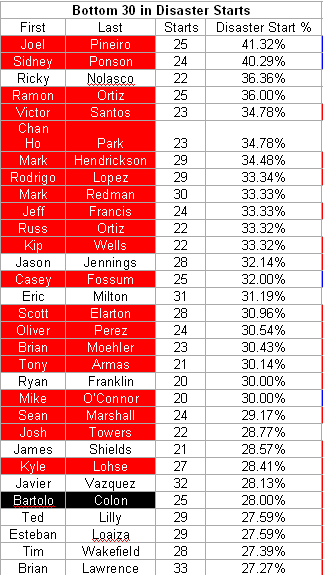
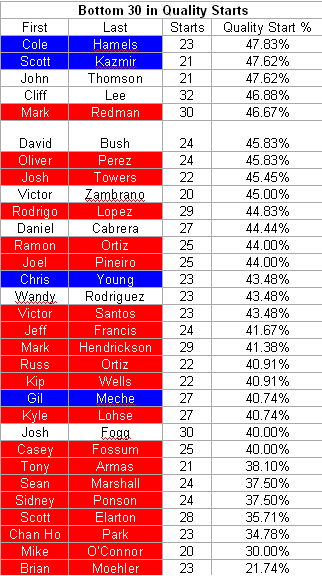
In this case the Red represents the Pitchers we really don't want, they aren't producing Quality Starts or avoiding Disaster Starts.
Since the repeats on this list probably don't need to be discussed in too much length, the names I would pay attention to include: Oliver Perez, Kip Wells, Ramon Ortiz, Kyle Lohse, and Jeff Francis. Most of these pitchers are off to strong starts this year but have an extended track record of under-performance. If you're one of their owners you're depending on one of these players bucking their 3 year trends and playing a bit with fire.
What's interesting here are the Blues and the one Black. The one Black being Bartolo Colon who as a fly-ball pitcher with spotty control at times tends to be all or nothing as a total of 88% of his starts end in Disaster or Quality. On the Blues side we have Meche, Young, Kazmir, and Hamels. All of these pitchers are younger pitchers that have had trouble with high pitch counts and subsequently haven't been able to last long enough in games to notch quality starts.
But again for the purpose of this study, we'd like to analyze those players that are poor at avoiding the Disaster Starts that can set your season back. In this case some of the more prominent names on the list include: Javier Vazquez, James Shields, Ted Lilly, Tim Wakefield, and Esteban Loaiza. Lilly, Wakefield, and Shields all spent these 3 seasons pitching in the AL East, the toughest division in all of baseball which likely explains some of the blowups. Regardless the whole bunch should be treated with a bit of kid gloves and should be spot-started to really take advantage of matchups.


